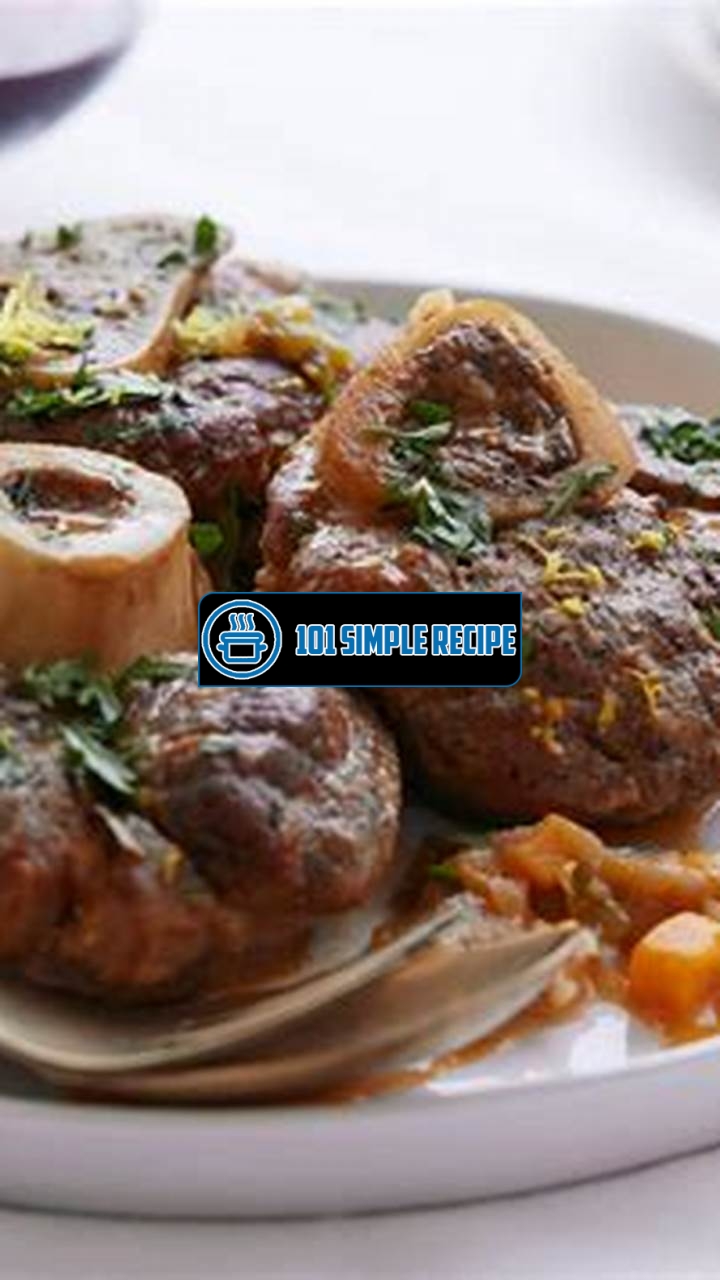If you’re looking to impress your dinner guests with a tantalizing Italian dish, then mastering the art of cooking Osso Buco should be at the top of your culinary to-do list! ️ This traditional Milanese recipe consists of braised veal shanks, slow-cooked to perfection in a rich broth, resulting in tender meat that falls off the bone. Whether you’re a seasoned chef or a novice in the kitchen, this step-by-step guide will help you create a truly unforgettable Osso Buco dish that will leave everyone craving for more. So gather your ingredients, put on your apron, and let’s embark on this delightful culinary journey together!

The History of Osso Buco
The origins of the famous Italian dish, osso buco, can be traced back to the northern region of Lombardy. Lombardy is known for its rich culinary tradition, and osso buco is one of its most beloved specialties.
The Origins of Osso Buco
The name “osso buco” translates to “bone with a hole” in Italian. This refers to the marrow-filled bone at the center of the dish, which is a key ingredient in its unique flavor. The dish is traditionally made with veal shanks, although modern variations may also use beef or pork shanks.
Traditional Ingredients and Flavors
Traditional osso buco is made with a variety of ingredients that impart a distinct and savory flavor. The recipe typically includes carrots, celery, onions, garlic, tomatoes, white wine, and broth. These ingredients are simmered together for several hours, allowing the flavors to meld and develop. The result is a rich and hearty dish with tender meat and a velvety sauce.
One of the key flavor components of osso buco is gremolata, a garnish made with lemon zest, garlic, and parsley. The bright and fresh flavors of the gremolata add a vibrant contrast to the rich and meaty dish.
Notable Variations of Osso Buco
While the traditional osso buco recipe is widely cherished, there are also notable variations of this dish that have emerged over time. Some regions may add additional ingredients such as mushrooms or anchovies to enhance the flavors. Others may substitute the veal shanks with different cuts of meat to create a unique twist on the classic dish.
No matter the variation, osso buco continues to be a beloved Italian favorite that showcases the country’s rich culinary heritage. Whether enjoyed at a rustic trattoria or prepared at home, this iconic dish is sure to impress and satisfy.
The Science Behind a Perfect Osso Buco
When it comes to cooking osso buco, there are several key factors that contribute to creating a tender and flavorful dish. By understanding the science behind this popular Italian recipe, you can elevate your culinary skills and impress your guests with a restaurant-quality meal.
The Role of the Cut of Meat
The cut of meat used in osso buco plays a crucial role in determining the final result. Traditionally, osso buco is made using cross-cut veal shanks, which include both the bone and the marrow. This cut is known for its rich flavor and the gelatinous texture it imparts when cooked slowly. The bone marrow adds an extra depth of flavor and creates a luxurious mouthfeel that distinguishes osso buco from other braised dishes.
In recent years, variations of osso buco have emerged, using different cuts of meat such as beef or pork shanks. While these alternatives can still result in a delicious dish, they may lack the authentic flavor and texture that veal shanks provide.
The Importance of Proper Braising Techniques
Braising is a cooking method that involves searing the meat at high heat and then simmering it slowly in a flavorful liquid. This technique is essential for achieving a tender and succulent osso buco.
One key step in the braising process is the initial searing of the meat. This step helps to develop a caramelized crust on the surface of the shanks, which adds complexity and depth of flavor to the dish. It also helps to lock in the juices and keep the meat moist during the long cooking process.
After searing, the osso buco is traditionally braised in a mixture of broth, wine, and aromatics. The dish is then cooked on low heat for an extended period, allowing the collagen in the meat to break down and transform into gelatin. This process results in a tender and melt-in-your-mouth texture that is characteristic of a perfectly cooked osso buco.
Enhancing Flavor with Aromatics and Herbs
To take your osso buco to the next level, it’s important to use a combination of aromatics and herbs that complement the rich flavors of the meat. Classic aromatics include onions, carrots, and celery, which form the base of the braising liquid.
In addition to the standard aromatics, you can personalize your osso buco by adding other ingredients such as garlic, tomatoes, or even a touch of citrus zest. These flavors will infuse into the braising liquid and enhance the overall taste of the dish.
When it comes to herbs, the most commonly used in osso buco are rosemary, thyme, and bay leaves. These herbs add a fragrant aroma and contribute to the overall complexity of flavors. It’s important not to overwhelm the dish with too many herbs, as you want the taste of the meat to shine through.
By mastering the art of cooking osso buco and understanding the science behind it, you can create a dish that is tender, flavorful, and truly unforgettable. Remember to choose the right cut of meat, braise it with care, and enhance the flavors with a carefully selected blend of aromatics and herbs. Bon appétit!
Choosing the Right Ingredients
When it comes to mastering the art of cooking Osso Buco, choosing the right ingredients is key to achieving the best results. Each component plays a crucial role in creating the perfect dish. Let’s delve into the essential ingredients that you need:
The Ideal Cut of Meat for Osso Buco
The star ingredient of Osso Buco is the veal shanks, specifically from the hind part of the calf. These shanks contain a good amount of marrow, which lends a rich and velvety texture to the dish. Opt for shanks that are fresh and evenly sliced, ensuring uniform cooking.
Perfecting the Flavorful Broth
A flavorful broth is the foundation of any delicious Osso Buco. It adds depth and richness to the dish. Start with a base of aromatic vegetables such as carrots, onions, and celery. Sauté them in olive oil until they become tender and golden. This will create a flavorful base for the broth.
⏰ Simmering the broth for an extended period allows the flavors to meld together harmoniously. Add some chicken or beef stock, along with a generous amount of white wine, to enhance the taste profile of the dish.
Note:
For a healthier alternative, you can use vegetable stock instead of the traditional meat-based one. This will provide a lighter but equally delicious taste.
Exploring Seasoning and Spices
The right combination of seasoning and spices can elevate the flavors of your Osso Buco. Apart from salt and pepper, you can experiment with various herbs like bay leaves, thyme, and rosemary to add depth and aroma.
️ If you prefer a bit of heat, you can include a pinch of red pepper flakes or chili powder. These spices will give your Osso Buco a subtle kick without overpowering the overall taste.
Tomatoes are another important component that adds tanginess to the dish. You can use either canned tomatoes or fresh tomatoes, depending on your preference. Cooking them down with the broth and other ingredients will infuse the Osso Buco with a delightful acidity.
Finally, don’t forget to garnish your Osso Buco with some freshly chopped parsley. This will not only add a pop of color but also bring a refreshing note to the dish.
By selecting the right ingredients and paying attention to the details, you can master the art of cooking Osso Buco. Remember to use fresh, high-quality veal shanks, create a flavorful broth, and experiment with a combination of seasonings and spices. With practice and patience, you’ll be able to create a truly exceptional Osso Buco that will impress your guests every time!
Mastering the Cooking Process
When it comes to cooking osso buco, mastering the cooking process is essential to achieving a delicious and tender dish. With the right techniques and attention to detail, you can elevate this classic Italian dish to a whole new level. Here is a step-by-step guide to help you master the art of cooking osso buco.
Prepping the Meat and Ingredients
Before you start cooking osso buco, it’s important to properly prep the meat and gather all the necessary ingredients. This will ensure that your dish turns out flavorful and tender.
1. Choose the Right Cut of Meat – Osso buco is traditionally made with veal shanks, but you can also use beef shanks if preferred. Make sure to choose shanks with plenty of marrow, as this adds richness and flavor to the dish.
2. Season the Meat – Generously season the meat with salt and pepper on both sides. This will enhance the flavor and help to create a flavorful crust when searing.
3. Gather the Ingredients – In addition to the meat, you will need the following ingredients: onions, carrots, celery, garlic, tomato paste, white wine, beef broth, and fresh herbs such as rosemary and thyme.
The Proper Braising Technique
Braising is the key to achieving tender and succulent osso buco. This cooking technique involves searing the meat and then simmering it slowly in a flavorful liquid. Here’s how to do it right:
1. Sear the Meat – Start by heating oil in a large, oven-safe pot over medium-high heat. Sear the meat on all sides until it develops a golden brown crust. This will lock in the flavors and create a tasty base for the dish.
2. Saute the Vegetables – Remove the meat from the pot and set it aside. In the same pot, sauté the onions, carrots, and celery until they become soft and translucent. This will add depth of flavor to the dish.
3. Deglaze with Wine – Add tomato paste and cook for a minute until it becomes fragrant. Then, pour in the white wine and scrape the bottom of the pot to release any flavorful bits stuck to it. This step will add richness to the sauce.
4. Simmer Slowly – Place the seared meat back into the pot and pour in enough beef broth to cover the shanks halfway. Add fresh herbs and seasonings. Cover the pot with a lid and simmer over low heat for about 2 to 3 hours, or until the meat becomes fork-tender. This slow cooking process allows the flavors to meld together and the meat to become incredibly tender.
Known Mistakes to Avoid
While cooking osso buco, there are a few common mistakes that can affect the final result. Here are some mistakes to avoid:
1. Overcooking the Meat – Overcooking the meat can result in a dry and tough texture. It’s important to monitor the cooking process and remove the meat from the pot as soon as it becomes fork-tender.
2. Not Browning the Meat Properly – The browning process adds depth of flavor to the dish. Make sure to sear the meat well on all sides to achieve a rich crust before braising.
3. Using Poor-Quality Ingredients – The quality of your ingredients can greatly impact the final taste of the dish. Make sure to use fresh and high-quality meat, vegetables, and seasonings for the best results.
4. Skipping the Deglazing Step – Deglazing the pot with wine is crucial for flavor development. It helps to scrape up the browned bits from the bottom of the pot and adds a rich, complex taste to the sauce.
By following these tips and techniques, you can master the art of cooking osso buco and create a dish that is bursting with flavors. Whether you’re cooking for a special occasion or simply wanting to indulge in a hearty and satisfying meal, this recipe is sure to impress.
Pairing and Serving Suggestions
When it comes to mastering the art of cooking Osso Buco, the right pairing and serving suggestions can take your dish from good to extraordinary. To ensure your Osso Buco masterpiece is met with resounding applause, we’ll explore some classic side dishes, wine pairings, and beautiful plating ideas that are sure to impress your guests. So let’s dive in and discover the best accompaniments for this delectable dish!
Classic Side Dishes for Osso Buco
No Osso Buco feast is complete without the perfect side dishes to enhance its flavors. Here are some classic options to consider:
- Gremolata: This zesty garnish of lemon zest, garlic, and parsley adds a burst of freshness to Osso Buco. Its citrusy notes beautifully balance the richness of the dish. ✨
- Risotto alla Milanese: Creamy, saffron-infused risotto is the ideal accompaniment to Osso Buco. The flavors blend together harmoniously, creating a luxurious culinary experience.
- Pureed Potatoes: Smooth and velvety mashed potatoes provide a comforting and mellow contrast to the robust flavors of Osso Buco.
- Polenta: This creamy cornmeal dish has a slightly grainy texture that complements the tender meat of Osso Buco. It’s a traditional pairing that never disappoints.
Wine Pairings to Elevate the Experience
A delightful glass of wine can elevate the Osso Buco experience to new heights. Here are some wine pairings that perfectly complement this classic Italian dish:
- Barolo: Known as the “King of Wines,” Barolo is a full-bodied red wine with rich fruit flavors and intense aromas. Its robust nature pairs exceptionally well with the hearty flavors of Osso Buco.
- Chianti Classico: This Tuscan red wine boasts a perfect balance of flavors and acidity. With its cherry and plum notes, it provides a delightful harmony when sipped alongside Osso Buco.
- Gavi: If you prefer white wine, Gavi is an excellent choice. This refreshing and crisp Italian white wine, made from the Cortese grape, offers a citrusy profile that beautifully complements the flavors of Osso Buco.
Impress Your Guests with Beautiful Plating
As they say, we first eat with our eyes. So why not make your Osso Buco presentation as delectable as the dish itself? Here are some tips to impress your guests with beautiful plating:
- Heighten with Gremolata: Sprinkle a vibrant and aromatic gremolata on top of the Osso Buco. The pop of green and citrusy aroma will add an alluring touch.
- Serve with Care: Place the tender Osso Buco on a bed of creamy risotto or polenta, creating an inviting base for the dish. This not only enhances the visual appeal, but also adds layers of flavors. ️
- Garnish with Fresh Herbs: Add a touch of elegance by garnishing the plate with a few sprigs of fresh herbs, such as parsley or thyme. The vibrant colors and aromas will make your dish visually captivating.
- Use Colorful Side Dishes: Pair your Osso Buco with vibrant and colorful side dishes, like roasted vegetables or a salad with a variety of fresh greens. The contrasting colors will make the whole plate pop.
By following these pairing and serving suggestions, your Osso Buco creation will undoubtedly be a culinary masterpiece that wows your guests. So gather your ingredients, fire up the stove, and let your cooking skills shine as you master the art of Osso Buco! ️✨
Thank you for taking the time to read our article on the best osso buco recipe. We hope you found it informative and inspiring for your next culinary adventure. Remember, the key to a delicious osso buco is slow cooking and flavorful ingredients. Don’t forget to visit us again for more mouthwatering recipes and cooking tips. Happy cooking!
Frequently Asked Questions
Here are some frequently asked questions about osso buco:
| No. | Questions | Answers |
|---|---|---|
| 1. | What cut of meat is best for osso buco? | The best cut of meat for osso buco is cross-cut veal shanks. |
| 2. | What is gremolata? | Gremolata is a mixture of lemon zest, garlic, and parsley that is traditionally served with osso buco to enhance its flavors. |
| 3. | Can I use beef instead of veal? | Yes, you can substitute veal with beef shanks if you prefer. |
| 4. | How long does osso buco need to cook? | Osso buco needs to cook for approximately 2-3 hours until the meat is tender and falls off the bone. |
| 5. | What can I serve with osso buco? | Osso buco pairs well with risotto, creamy polenta, or mashed potatoes. |
| 6. | Can I make osso buco ahead of time? | Yes, osso buco actually tastes even better when made a day in advance and reheated. |
Get Cooking with the Best Osso Buco Recipe Today
Now that you have all the essential tips and tricks for preparing the best osso buco, it’s time to put your culinary skills to the test. Gather your ingredients, pour yourself a glass of wine, and get ready to create a delicious and satisfying dish that will impress everyone at the table. Don’t forget to share your cooking adventures with us and come back soon for more delectable recipes. Enjoy!
Jump to Recipe
Best Osso Buco Recipe

Learn how to make the best osso buco with this easy-to-follow recipe. Slow cooked veal shanks in a rich and flavorful tomato-based sauce, served with gremolata, and paired with creamy risotto.
- 4 veal shanks (about 2 inches thick)
- 1/2 cup all-purpose flour
- 2 tablespoons olive oil
- 1 onion (chopped)
- 2 carrots (chopped)
- 2 celery stalks (chopped)
- 3 garlic cloves (minced)
- 1 cup dry white wine
- 1 can (14 oz crushed tomatoes)
- 1 cup beef broth
- 1 bay leaf
- 1 sprig fresh thyme
- Salt and pepper (to taste)
- Gremolata (for serving)
- Preheat the oven to 325°F (160°C).
- Dredge the veal shanks in flour, shaking off any excess.
- Heat the olive oil in a large Dutch oven or deep skillet over medium-high heat. Brown the veal shanks on all sides until golden brown. Remove and set aside.
- In the same pan, add the chopped onion, carrots, celery, and minced garlic. Sauté for 5-7 minutes until the vegetables are tender.
- Deglaze the pan with white wine, scraping the bottom to release any browned bits. Simmer for 3-4 minutes until the wine has reduced.
- Add the crushed tomatoes, beef broth, bay leaf, and fresh thyme to the pan. Season with salt and pepper to taste. Stir to combine.
- Return the browned veal shanks to the pan, nestling them into the sauce. Cover the pan with a lid and transfer to the preheated oven. Braise for 2-3 hours until the meat is tender and falls off the bone.
- Remove the veal shanks from the pan and transfer to serving plates. Spoon the sauce over the shanks and sprinkle with gremolata. Serve with risotto or your choice of side dish.






